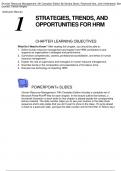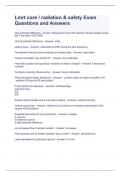(Human Resource Management, 5th Canadian Edition By Sandra Steen, Raymond Noe, John Hollenbeck, Barr
Gerhart, Patrick Wright)
(Instructor Manual)
STRATEGIES, TRENDS, AND
1 OPPORTUNITIES FOR HRM
CHAPTER LEARNING OBJECTIVES
What Do I Need to Know? After reading this chapter, you should be able to:
1. Define human resource management and explain how HRM contributes to and
supports an organization’s strategies and performance.
2. Summarize competencies, careers, professional accreditation, and ethics in human
resource management.
3. Explain the role of supervisors and managers in human resource management.
4. Describe trends in the composition and expectations of the labour force.
5. Discuss how technology is impacting HRM
POWERPOINT® SLIDES
Human Resource Management, Fifth Canadian Edition includes a complete set of
Microsoft PowerPoint® files for each chapter. In the lecture outline that follows, a
thumbnail illustration of each slide for this chapter is placed beside the corresponding
lecture material. The slide number helps you to see your location in the slide show
sequence and to skip slides that you don’t want to show to the class. (To jump ahead
or back to a particular slide, just type the slide number and hit the Enter or Return key.)
Steen, HRM 5ce © McGraw-Hill Education, 2019
IM 1-1
, ®
LECTURE OUTLINE (with PowerPoint slides)
Prepared by: Sandra Steen, University of Regina
STRATEGIES, TRENDS, AND OPPORTUNITIES FOR HUMAN
RESOURCE MANAGEMENT
Strategies, Trends, and
LEARNING OBJECTIVES
Opportunities for HRM LO1: Define human resource management and explain how HRM contributes to
Slide 1
and supports an organization’s strategy and performance.
LO2: Summarize competencies, careers, professional accreditation, and ethics in
human resource management.
LO3: Explain the role of supervisors and managers in human resource
management.
Learning Objectives LO4: Describe trends in the composition and expectations of the labour force.
Slide 2 LO5: Discuss how technology is impacting HRM.
EARNING A REPUTATION AS A GREAT EMPLOYER: SHOPIFY
Organizations strive to create an employment brand that attracts top talent
and earns a reputation as a great place to work
• Headquartered in Ottawa, e-commerce software solutions and web builder
Earning a Reputation as a Shopify has been rated as the best place to work in Canada by Glassdoor
Great Employer: Shopify
Slide 3 and was recently ranked third of global tech employers by Hired.com
• The ‘trust battery’ is central to our culture.” Trust battery is a metaphor key
to the high-performance culture and employee experience at Shopify. CEO
Tobi Lütke explains, “It’s charged at 50 percent when people are first hired.
And then every time you work with someone at the company, the trust
battery between the two of you is either charged or discharged, based on
things like whether you deliver on what you promise.”
HRM PRACTICES
Human resource management (HRM) centres on the policies, practices, and
systems that influence employees’ behaviour, attitudes, and performance
• Important HR (people) practices include:
HRM Practices
Slide 4 -- Analysis and design of work
-- Workforce planning (determining how many employees with specific
knowledge and skills are needed)
-- Recruiting (attracting candidates) and Selection (choosing employees)
-- Training, learning, and development (preparing employees how to perform their
jobs and for the future)
-- Performance management (supporting performance)
-- Total rewards (rewarding employees)
-- Employee and labour relations (creating a positive work environment)
Steen, HRM 5ce © McGraw-Hill Education, 2019
IM 1-2
, WHY ARE PEOPLE SO VALUABLE?
Managers and economists traditionally have seen HRM as a necessary expense, rather
than a source of value to their organizations
• Human capital—an organization’s employees, described in terms of their
Why are People So training, experience, judgment, intelligence, relationships, and insight
Valuable?
Slide 5
• Organizations need resources that provide competitive advantage
and human resources have these qualities:
-- Valuable, rare, cannot be imitated, and have no good substitutes
• Employee engagement refers to the degree to which employees are fully
involved in their work and the strength of their commitment to their job and
the organization.
IMPACT OF HRM
HRM contributes to measures of an organization’s success such as quality, profitability
and customer experience
Impact of HRM
Slide 6
WHAT ARE THE RESPONSIBILITIES OF HR DEPARTMENTS?
HR as a business within the organization with 3 product lines:
1. Administrative services and transactions
• Handling administrative tasks e.g. processing tuition reimbursement
applications and employee queries
What are the Responsibilities
of HR Departments? • Requires efficiency and commitment to quality
Slide 7 • Requires expertise in the particular tasks
2. Business partner services
• Developing effective HR systems to meet organizational goals
• HR people must understand the business to understand what the business
needs
What are the Responsibilities
3. Strategic partner
of HR Departments? (cont’d) • Contributing to the company’s strategy
Slide 8 • HR professionals must understand the business, industry, and competitors
What are the Responsibilities
of HR Departments? (cont’d)
Slide 9
Steen, HRM 5ce © McGraw-Hill Education, 2019
IM 1-3
, EMPLOYEE EXPERIENCE
• Perceptions that employees have about their experiences at work in
response to their interactions with the organization
Employee Experience
Slide 10
• Providing a positive employee experience is critical for keeping employees
engaged and committed to the organization
• Encompasses all of the elements that influence an employee’s perception
of the work environment and becomes an important focus for the
employee’s entire journey—from first contact with a potential employer to
retirement (and even beyond)
RESPONSIBILITIES OF HUMAN RESOURCE DEPARTMENTS
1. Analyzing and Designing Jobs
• Job analysis is the process of getting detailed information about jobs
• Job design is the process of defining the way work will be performed and
Responsibilities of HR the tasks that a given job requires
Departments
Slide 11 2. Workforce Planning
• Identifying the number and types of employees the organization needs
3. Recruiting and Hiring Employees
• Recruitment is the process through which the organization seeks
applicants for potential employment
• Selection is the process by which the organization attempts to identify
applicants with the necessary knowledge, skills, abilities, and other
characteristics that will help the organization achieve its goals
4. Training, Learning, and Development
• Training is a planned effort to enable employees to learn job-related
knowledge, skills, and behaviour
• Development involves acquiring knowledge, skills, and behaviours that
improve employees’ ability to meet the challenges of new or existing jobs
5. Performance Management
• Performance management is the process of ensuring that employees’
activities and outputs match the organization’s goals
6. Total Rewards
• Planning pay and benefits involves many decisions including understanding legal
requirements; administering pay and benefits requires systems and extensive record-
keeping and reporting; and ensuring compliance with laws
7. Maintaining Positive Employee and Labour Relations
• Provide for satisfying and engaging work environments and maintaining positive relations
with employees and positive labour relations
8. Establishing and Administering Human Resource Policies
• HR helps establish policies to provide for fair and consistent decisions
9. Managing and Using Human Resource Data
• People (human capital) analytics—use of quantitative tools and scientific
methods to analyze data from human resource databases and other
sources to make evidence-based decisions that support business goals
10. Ensuring Compliance with Federal/Provincial/Territorial Legislation
Steen, HRM 5ce © McGraw-Hill Education, 2019
IM 1-4





